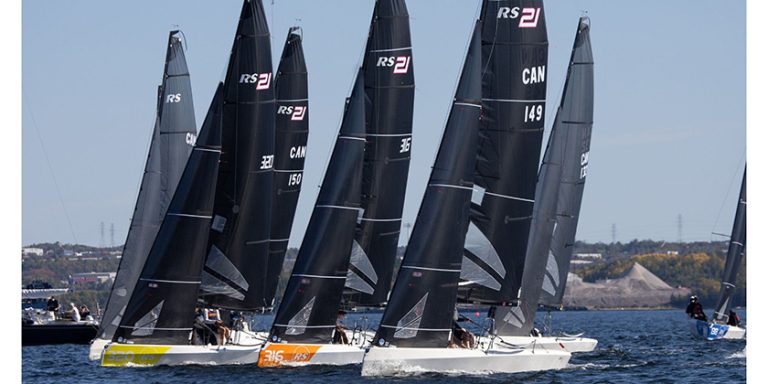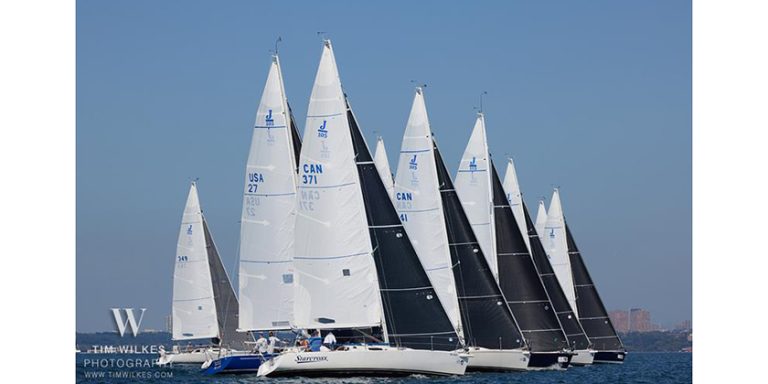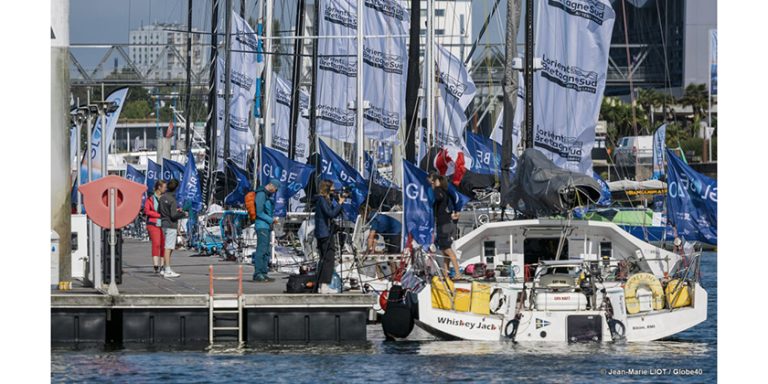A Sailor’s View of PHRF – Part 2

Mar 16, 2022
In Part 1, I presented the reasons for this article
The new logo for Mid-West PHRF is a circle with a picture of all the Great Lakes, excluding Lake Ontario. This appears to be a logical grouping. But the question is, can this vision ever be realized with PHRF being what it is?
There are now five different PHRF Rating Stations in the Great Lakes Region: The new Mid-West PHRF Association (MW-PHRF), Lake Ontario PHRF (LO-PHRF), Lake Erie PHRF (LE-PHRF), Lake Huron PHRF (LH-PHRF), and the Canadian Essex County PHRF Association (EC-PHRF).
The Chief-Handicappers from each of these PHRF Rating Station were interviewed, either on the phone or through an e-mail exchange. Each were asked if they knew about the merger between LM-PHRF and DRYA and the subsequent formation of Mid-West PHRF, and whether they were approached to join this new organization. I asked them whether they would consider joining or not. Not one Chief Handicapper suggested they could see what the benefits would be to their membership if they joined.
| LO-PHRF | 1500 certificates | } |
There is a total of 3200 PHRF certificates issued each year around in the Great Lakes Region |
| LE-PHRF | 430 certificates | ||
| LH-PHRF | 200 certificates | ||
| LM-PHRF | 720 certificates | ||
| DRYA | 300 certificates | ||
| EC-PHRF | 50 certificates |
Every PHRF Rating Station makes the claim they are unique, and the handicappers each say that they have different boats than all the others, or they sail in different conditions, therefore the data from one station is useless to the other. There will be a different rating for the same boat coming out of each station. I find these types of statements very hard to accept.
With the exception of Lake Superior, I’ve sailed on each of the Great Lakes, and I find they present, on average, basically the same sailing/weather conditions. Tac Boston of Doyle Boston Sails, Sarnia, who has sailed all the lakes (except Superior) told me: “There was no significant differences in conditions to justify having a different PHRF rating on every Lake for an identical boat.” I then emailed a friend, Greg Clarke to get his opinion, who for many years sailed on Lake Superior. His experience also includes four Trans-Superior races on his family’s C&C 37, hull #1, named Pennycrest. (He now sails on Lake Ontario.) So, I asked Greg: “Are the sailing conditions on these two lakes, Superior and Ontario, that different to justify a separate PHRF rating?” He answered: “June, July, and August are pretty much the same. LSYA (Lake Superior Yachting Association) and most of the clubs on the lake use Lake Michigan PHRF for their ratings.”
There are subtle differences among the Great Lakes, but, in my opinion, not enough to justify a separate rating for the same boat. I asked this same question to Geoff Moore of North Sails. He says: “The eastern shores of Lake Ontario tend to have more thermal wind (Toronto versus Kingston area). Lake Erie can have some amazingly square chop. Lake Michigan can have ocean size rollers in a multiday northerly. Western Lake Ontario is notorious for light air and flat water. Lake St Clair can also get choppy, and is generally pretty shallow with lots of weeds.” I personally find thunderstorms storms tend to be more frequent and more violent on Lake Clair as compared to Lake Ontario. I also find when the sea-breeze kicks in in the western part of Lake Ontario, which it typically always does, a nice breeze fills in and the conditions are no different than Lake Erie or Lake St Clair.
To win races, we have to learn how to sail fast in both light and heavy air, flat water, or in a heavy chop.
Some boats are faster than others in light air, while others are faster when the wind is up. Some do better in a chop than others. These differences are typically due to hull design, weight, rig tuning, and sail trim. The months of June, July, and August, for more than two-thirds of our season, we have the same sailing conditions basically across all the Great Lakes. Conditions average out.
Weather extremes tend to be seasonal, and typically the early spring and fall bring the higher winds and changing conditions. To me, a C&C 30, or a Catalina 30, or a Morgan 27, or a Morgan 35, etc., (traditional boats) on any one of the Great Lakes, if they are an identical boat, should rate the exact same regardless of where they sail. So, my question remains: “Why can’t there be a standard rating for any given boat across all the Great Lakes area?”
There is a variety of handicapping policies out there. Each rating station has their own opinions about the handicapping of like boats, and it appears each can take their own directions. I’m told a PHRF Rating Station can basically do what they want. They can use whatever methodology they want, assign any rating they want, regardless of what other larger or more mature rating stations of the area might suggest is more accurate. If PHRF (at the executive level) wants to be recognized as a ‘Class Association’ like all other racing classes out there, then it should be thinking about adopting a standard measurement policy.
During my interviews, I was told my line of questioning was focussed on the fairness of PHRF. It was sarcastically explained to me that PHRF is an ‘observed’ rule, and every locale has their one observation. The ideal is that the observers are able to assess the boat’s performance independent of their crew’s skill. Unfortunately, that is very hard if not impossible to do. One handicapper said: “We will go out and watch a start to see how well the applicant does. This helps with our assessment.”
What’s the dif?
Sailing one-design is a very different mindset than racing in a handicap division. You learn quickly that boat preparation matters, whereas the average club sailor racing on a Wednesday night does not appreciate this fact as much. This has been my experience. They typically don’t have other identical boats to race against, making it difficult to judge each other’s performance. At a one-design regatta, you will get the opportunity to tune-up against the top sailors …prior to the start, checking out boat speed and performance against each other. PHRF sailors rarely find or take this opportunity. Typically, one-design sailors know how to shift gears faster as the conditions change.
We have all experienced races where different crew skill levels often skew the observations of a boat’s performance. A few well-sailed boats at one regatta, can make it difficult for less skilled sailors to perform at the same level, in the same boat. PHRF is supposed to be about the performance potential of a boat. Therefore, in saying that, the view should be that the group of lesser skilled sailors should understand they have a performance target to reach… they need to learn and get better as sailors, and learn to sail faster around the race course, in all sailing conditions. Too many blame their rating for their poor performance.
The better crew on a well-prepared boat, should never get penalized because they were capable of sailing a boat to its potential. PHRF handicapping is not suppose to be a people handicapping system similar like golf, where the performance of the individuals is taken into consideration. This appears to be a dilemma for PHRF handicappers.
A big difference between a one-design fleet and a PHRF fleet, is the enforcement of the class rules. If your boat does not comply with its class rules, you are not allowed to race until the boat is fixed. You are disqualified. Simple as that – no hard feelings! PHRF fleets don’t do this. Sailors will complain about another boat, spread rumours about all kinds of stuff, but they will never submit anything formal to the handicappers or measurement committees. They say they don’t want to make enemies. We must remember sailing is a ‘gentlemen’s sport’ (and ladies). Those who do knowingly bend the rules need to re-read Rule 1. They should also familiarize themselves with Rule 69, because if you cheat, you can be banned from sailing. Turning a blind eye to cheating really hurts our sport. (That’s why the saying ‘Friends don’t let friends race PHRF’)
It is interesting to note
Two other PHRF rating stations around the Great Lakes area are in the exact same predicament DRYA found themselves this past year. There is no-one to replace the long-time volunteers who are looking to retire. The Chief Handicapper at LH-PHRF wants to retire and has no one to take his place. Nick Ward has been doing the job for 20 years. So much knowledge will be lost when he retires. There is no $$ charge to get a renew or to get a new certificate. He provides this service for free. This guy deserves a standing ovation!
LH-PHRF maintains a file of 200 certificates. Nick is worried that the sailors will not pay a $35 or $50 fee to get their certificate, and as a result, participation in races/regattas will drop right off. Nick feels the no-cost service seems to be the glue that is keeping this sailing community together. This is such a shame. The membership should never put such a dedicated volunteer in this situation. Nick’s role has been taken for granted. In the words of Joni Mitchell: “Don’t it always seem to go that you don’t know what you’ve got till it’s gone.”
EC-PHRF is in the same predicament. The Chief Handicapper says there is no-one to replace him either. There is no-one with the skill and knowledge. There has basically been no visible activity for 4 – 5 years with this Association. The published spread sheet records have not been updated in awhile. Their web-site is 5 years out of date. Participation between member clubs has dropped right off, which has nothing really to do with Covid restrictions. For the benefit of racing around Essex County, the members themselves must realize the time has come to look at options, to look at MW-PHRF if handicap racing is going to survive around Essex County. They will argue they should get a certificate from a Canadian Station, not an American one. I can only ask, what the hell difference does it make? “Essex County PHRF sailors are welcome to get PHRF certificates from MW-PHRF; simply declare they are in Region 9, and they will be rated same as DRYA boats” says Tim Prophit.
There is a handful of PHRF sailors on the Canadian side who are still convinced they are ‘unique’ and who still believe the old ideology of the founding fathers of 60+ years ago, that your rating should change if you go to the other side of our little lake to race, because “it matters who you race against”. It is my opinion that it is this type of nonsense that has caused PHRF racing to get its poor reputation.
In Part 3 we will look at ways PHRF can mature (if it wants to, and if the sailors want it to)
 Roger Renaud
Roger Renaud
Born in Windsor, Ontario, Roger moved to Toronto for work in the early 70’s where he sailed a Hobie off Cherry Beach. Eventually joining ABYC, he has owned three different Thunderbirds over the years. The E-22, Laser 28, CC27, CC34, CC99, and Beneteau First 36.7’s were the other larger one-design fleets he sailed in, each for a few years dedicated to a program. He was also involved in a significant three-year program on a Nelson Marek 36, Maggie Kelly, out of RCYC.
Since returning to Windsor, he has been winning locally and in DYRA PHRF divisions.















